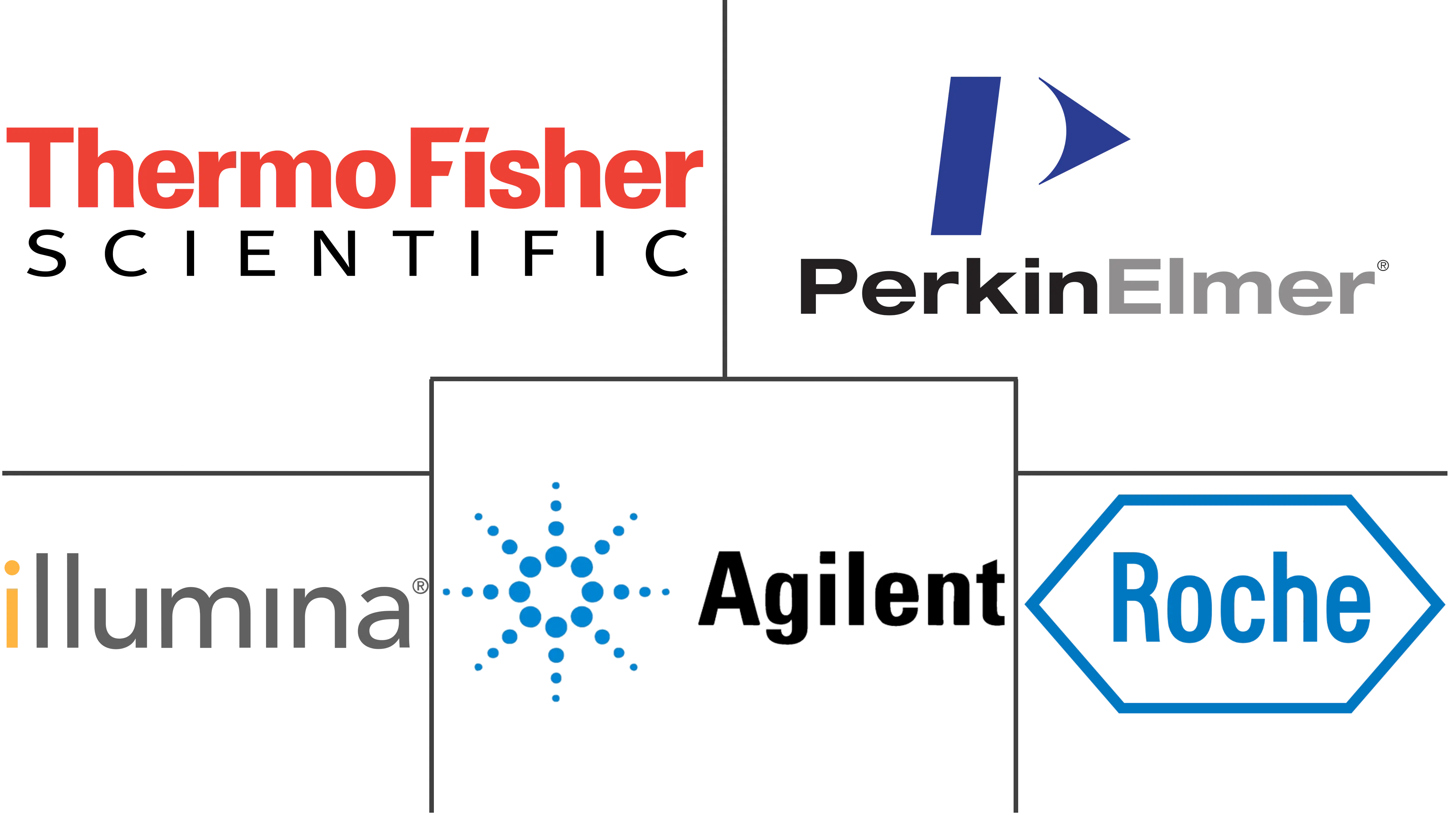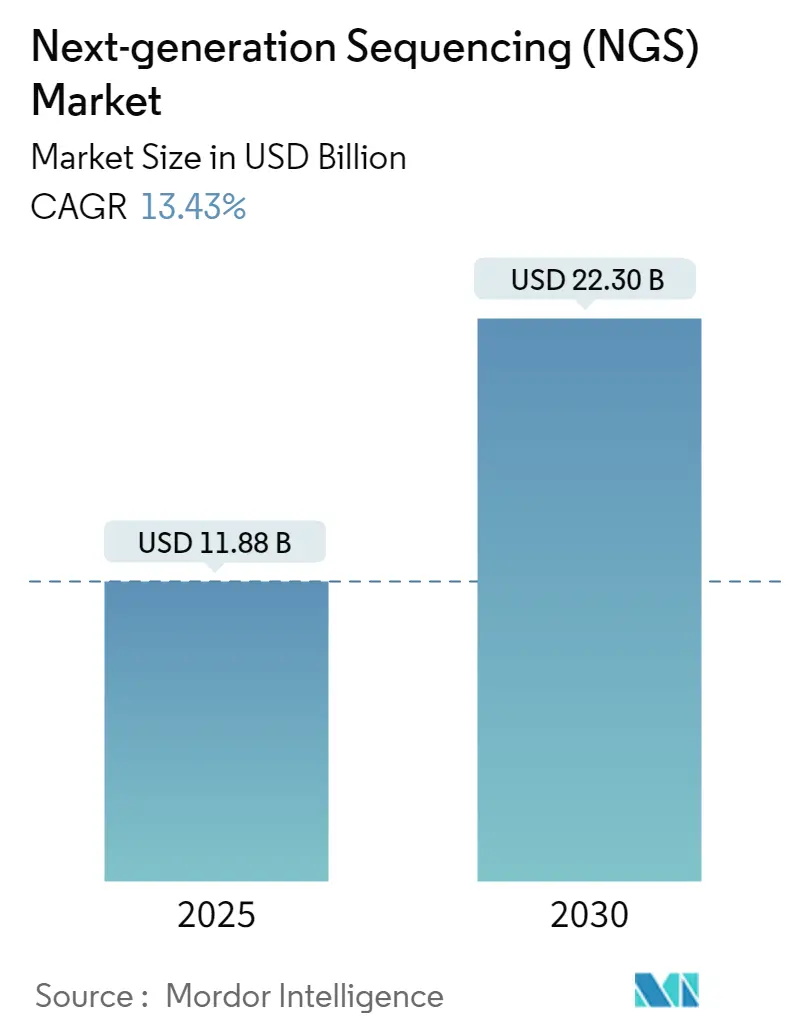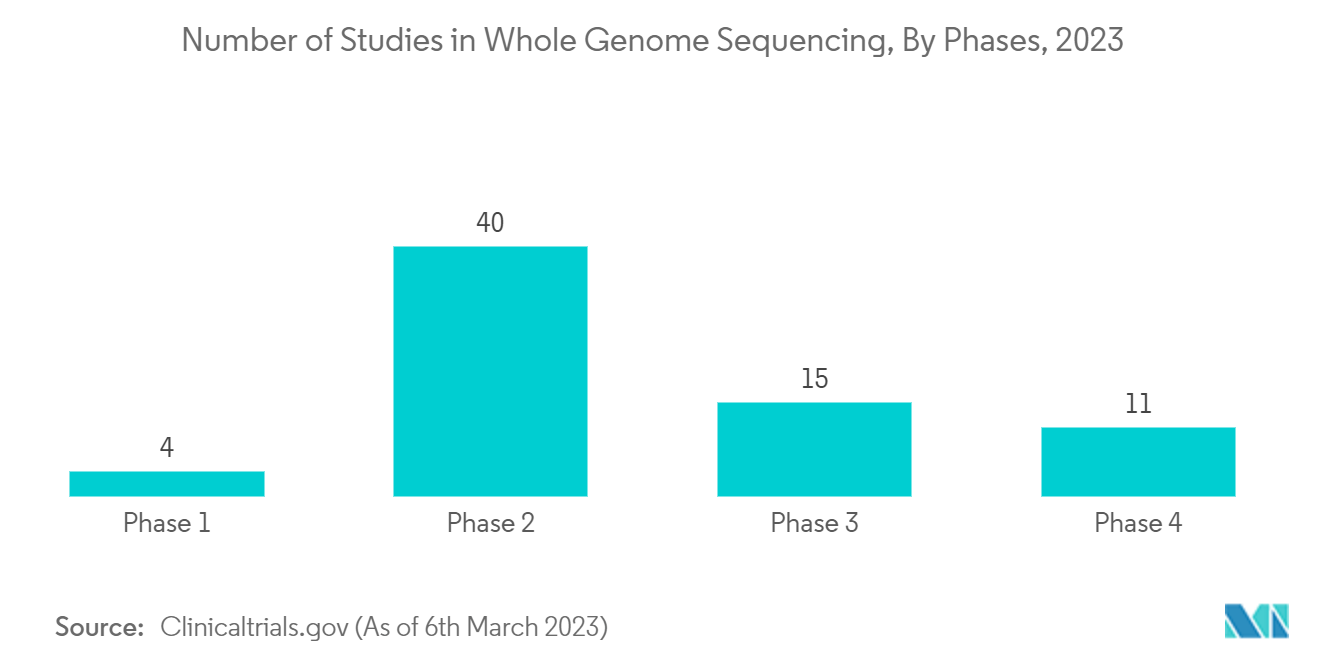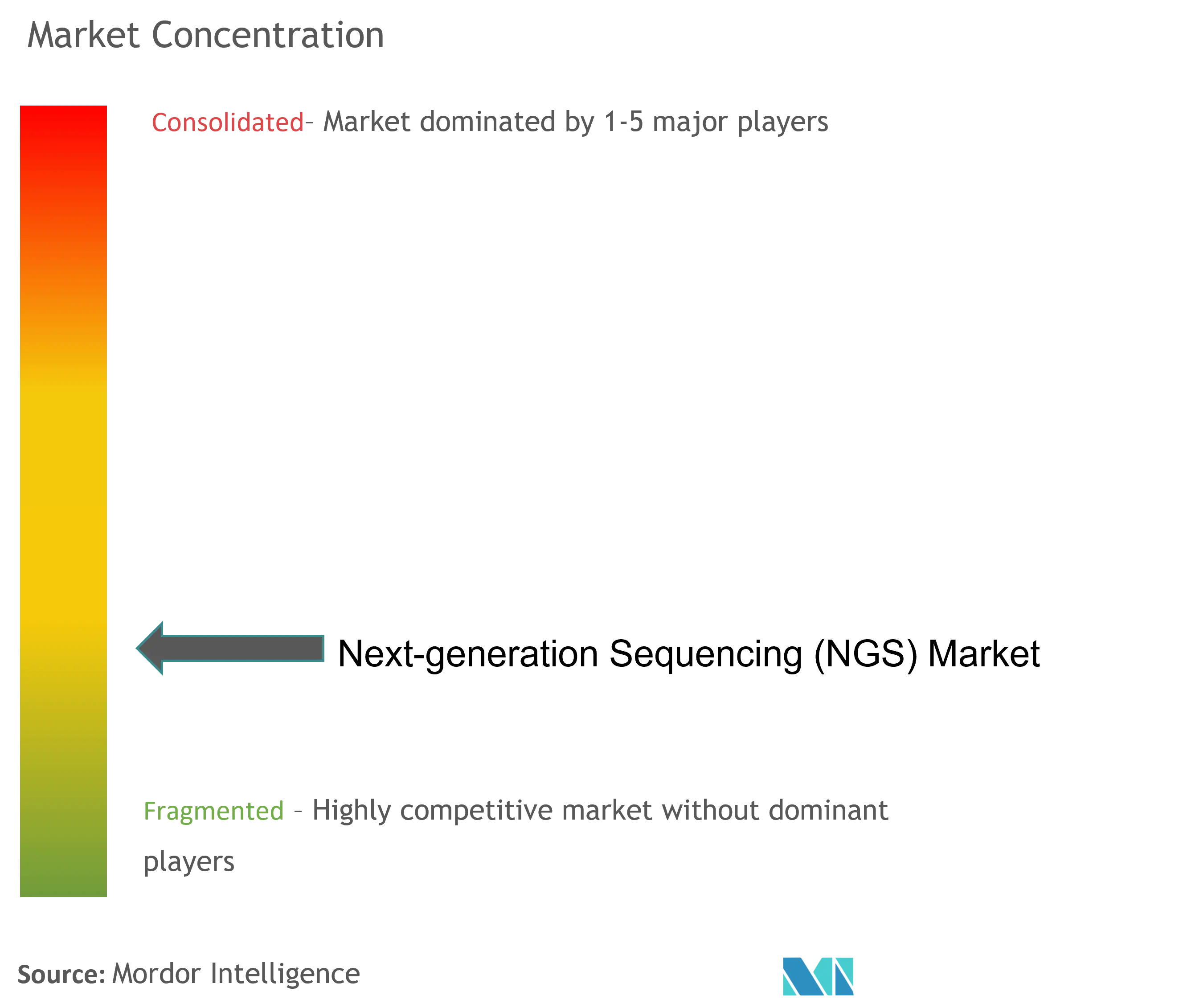Next Generation Sequencing (NGS) Market Analysis
The Next-generation Sequencing Market size is estimated at USD 11.88 billion in 2025, and is expected to reach USD 22.30 billion by 2030, at a CAGR of 13.43% during the forecast period (2025-2030).
The NGS diagnostic technology was able to find out a virus's genetic sequence and helped scientists figure out how mutations happen. During the COVID-19 pandemic, governments all over the world worked with the private sector to try to get NGS technology on the market as a possible diagnostic tool.For example, an article published by Frontiers in March 2022 says that next-generation sequencing (NGS) was used to study COVID-19, which made it much easier to find out where SARS-CoV-2 came from.It also said that NGS was important for looking into the possible origins and workings of SARS-CoV-2 in order to stop the spread of COVID-19 and make the treatment plan even better.Thus, the use of NGS technology increased throughout the pandemic phase. However, post-pandemic, the NGS market is expected to have stable growth during the forecast period of the study.
Factors such as the increasing applications in clinical diagnosis and speed, cost, and accuracy, and the increasing efficiency when compared to traditional technologies such as microarrays and the rising number of drug discovery applications are expected to boost market growth.
An upsurge in the use of NGS technology in clinical diagnosis and the speed, cost, and accuracy of this sequencing method are likely to boost the growth of the market. For instance, NGS has a lot of advantages over conventional sequencing techniques, according to an article from PubMed Central published in January 2021.These advantages include a higher throughput with sample multiplexing, a higher sensitivity for finding low-frequency variants, a faster turnaround time for high sample volumes, and a lower cost.Additionally, a PubMed Central article from April 2021 claimed that because NGS is capable of massively parallel sequencing and is steadily replacing its predecessor, conventional Sanger sequencing, it has significantly influenced the demand for more affordable and quick sequencing technologies.It is expected that NGS's advantages will help the market grow over the next few years.
The market is also expected to grow because replacing old technologies like microarrays will make them more efficient and because more drug discovery applications will need NGS technology.For example, an article published by Elsevier in August 2022 said that NGS was better than microarrays at detecting DNA and doing other genomic tasks.
Additionally, several market players are playing a key role in the development of drugs through this technology, which is also expected to boost market growth. For example, in January 2022, Illumina Inc. and Nashville Biosciences LLC, a wholly-owned subsidiary of Vanderbilt University Medical Center (VUMC), signed a multi-year agreement to speed up the development of new medicines through large-scale genomics and the creation of a leading clinical genomic resource using Illumina's next-generation sequencing (NGS) platforms.
Hence, the aforementioned factors, such as the rising developments by key market players, the efficiency in replacing the traditional technologies (such as microarrays), growing drug discovery applications demanding NGS technology, and an upsurge in the use of NGS technology in clinical diagnosis, are expected to boost the market's growth. However, factors such as legal and ethical issues, the interpretation of complex data, and the lack of skilled professionals are expected to impede market growth.
Next Generation Sequencing (NGS) Market Trends
The Whole Genome Sequencing Segment is Expected to Grow at a Significant Rate Over the Forecast Period
The whole-genome sequencing segment is expected to grow substantially over the coming years. Whole-genome sequencing (WGS) has been widely accepted for providing the highest possible resolution information about various diseases and other genetic analyses. For instance, according to the article published by NCBI, whole genome sequencing (WGS) can provide unprecedentedly relevant information regarding the malaria parasite genome used for malaria pathology. In addition to the same article, the advent of next-generation sequencing is making WGS a standard in the field of disease management and reduction.
Moreover, numerous initiatives undertaken by universities, academic and research institutions, and research establishments to utilize WGS technology in identifying the root cause of diseases are likely to propel the segment's growth. For instance, in February 2021, Stanford Medicine launched an in-house service for whole-genome sequencing. The whole-genome sequencing of various viruses was greatly simplified using the NGS-based test.
In the same way, the University College London reported in November 2022 that personalizing whole genome sequencing can double the number of rare diseases that can be diagnosed.All the patients who participated received whole genome sequencing via Genomics England's '100,000 Genomes Project" to try to find a genetic cause for their suspected primary mitochondrial disease (PMD). Thus, the increasing demand for whole genome sequencing is expected to boost the usage of NGS technology. Furthermore, the rising number of clinical trial studies pertaining to the use of whole-genome sequencing is also increasing the focus on whole-genome sequencing, thereby contributing to the market's growth.
Thus, due to the above-mentioned factors, such as numerous initiatives undertaken by universities, academic and research institutions, and research establishments for utilizing WGS technology in identifying the root cause of diseases and the rising advantages of whole genome sequencing, the segment is anticipated to witness healthy growth over the forecast period.
North America is Expected to Hold a Significant Share of the Market Over the Forecast Period
North America is expected to hold a significant share of the market and is expected to continue the trend over the coming years. Next-generation sequencing (NGS) technology is gaining popularity as a routine clinical diagnostic test. Factors such as the rising prevalence of chronic and infectious diseases, the increasing spending on genomics, and the rising developments by key market players are expected to boost market growth.
For instance, as per the Canada Cancer Society's statistics for 2022, around 6,700 Canadians were diagnosed with leukemia in 2021, out of which 4,000 were men and 2,700 were women. Also, as per the American Cancer Society's data for 2023, around 59,610 new cases of leukemia and 20,380 new cases of acute myeloid leukemia (AML) are expected to be diagnosed in the United States in 2023. Thus, the high incidence of such diseases is leading to an increase in the usage of NGS technology-based devices, thereby driving the market in the region.
Also, more money will be spent on genomics research, which is expected to increase the use of NGS-based devices and drive the growth of the market.For example, the National Institutes of Health (NIH) said in May 2022 that spending on cancer genomics in the United States would rise from USD 1,160 million in 2021 to USD 1,220 million in 2022.
The growth of the market is also expected to be helped by the fact that key market players are making more and more changes. For example, in September 2022, Predicine, Inc. said that the US FDA had given the PredicineCARETM cfDNA Assay, a Next-Generation Sequencing (NGS) assay for tumor mutation profiling in cfDNA isolated from liquid biopsy samples from cancer patients, breakthrough device designation.Similarly, in August 2022, Thermo Fisher Scientific announced that the United States FDA granted premarket approval to an NGS-based test known as the "Oncomine Dx Target Test' as a companion diagnostic (CDx) to identify patients whose tumors have HER2 (ERBB2) activating mutations (SNVs and Exon 20 Insertion) in non-small cell lung cancer (NSCLC) who may be candidates for ENHERTU (fam-trastuzumab deruxtecan nxki) as a companion diagnostic (CDx).
Thus, the aforementioned factors, such as the rising prevalence of chronic and infectious diseases, increasing spending on genomics, and the rising developments by key market players, are expected to boost market growth in the region.
Next Generation Sequencing (NGS) Industry Overview
The next-generation sequencing (NGS) market is highly fragmented, with the presence of several global and international players. The key players are adopting different growth strategies to enhance their market presence, such as partnerships, agreements, collaborations, new product launches, geographical expansions, mergers, and acquisitions. Some of the key players in the market are F. Hoffmann-La Roche Ltd., Thermo Fisher Scientific Inc., Agilent Technologies, Illumina Inc., and PerkinElmer Inc., among others.
Next Generation Sequencing (NGS) Market Leaders
-
Agilent Technologies
-
F. Hoffmann-La Roche Ltd
-
Illumina Inc.
-
PerkinElmer Inc.
-
Thermo Fisher Scientific Inc.
- *Disclaimer: Major Players sorted in no particular order
Next Generation Sequencing (NGS) Market News
- January 2023: QIAGEN announced a strategic partnership with California-based population genomics leader Helix to advance next-generation sequencing companion diagnostics in hereditary diseases.
- March 2023: The company SOPHiA GENETICS announced a new partnership with Qiagen that will pair QIAseq reagent technology with the DDM platform to enhance tumor analysis through next-generation sequencing (NGS).
- September 2022: Illumina Inc. launched the NovaSeq X Series (NovaSeq X and NovaSeq X Plus), new production-scale next-generation sequencers that will enable faster, more powerful, and more sustainable sequencing.
- March 2022: Thermo Fisher Scientific launched the CE-IVD-marked Ion Torrent Genexus Dx Integrated Sequencer, an automated next-generation sequencing (NGS) platform that delivers results in as little as a single day.
Next Generation Sequencing (NGS) Industry Segmentation
As per the scope of the report, NGS is a technology in which millions of DNA strands can be sequenced through massive parallelization. This technique is also known as high-throughput sequencing. The low cost, high accuracy and speed, and precise results, even from low sample inputs, are the main advantages NGS offers over Sanger's sequencing method. The next-generation sequencing market is segmented by Type of Sequencing (Whole Genome Sequencing, Targeted Resequencing, Whole Exome Sequencing, RNA Sequencing, CHIP Sequencing, De Novo Sequencing, and Methyl Sequencing), Product Type (Instruments, Reagents and Consumables, and Services)East and, End User (Hospitals and Healthcare Institutions, Academics, and Pharmaceutical and Biotechnology Companies), Application (Drug Discovery and Personalized Medicine, Genetic Screening, DiagnAgriculture,iculture and Animal Research, and Other Applications), and Geography (North America, Europe, Asia-Pacific, Middle East and AfriMiddlend South America). The market report also covers the estimated market sizes and trends for 17 different countries across major regions globally. The report offers market size and forecasts in value (in USD million) for all the above-mentioned segments.
| By Type of Sequencing | Whole Genome Sequencing | ||
| Targeted Resequencing | |||
| Whole Exome Sequencing | |||
| RNA Sequencing | |||
| CHIP Sequencing | |||
| De Novo Sequencing | |||
| Methyl Sequencing | |||
| By Product Type | Instruments | ||
| Reagents and Consumables | |||
| Services | |||
| By End-User | Hospitals and Healthcare Institutions | ||
| Academics | |||
| Pharmaceutical and Biotechnology Companies | |||
| By Application | Drug Discovery and Personalized Medicine | ||
| Genetic Screening | |||
| Diagnostics | |||
| Agriculture and Animal Research | |||
| Other Applications | |||
| Geography | North America | United States | |
| Canada | |||
| Mexico | |||
| Europe | Germany | ||
| United Kingdom | |||
| France | |||
| Italy | |||
| Spain | |||
| Rest of Europe | |||
| Asia-Pacific | China | ||
| Japan | |||
| India | |||
| Australia | |||
| South Korea | |||
| Rest of Asia-Pacific | |||
| Middle East and Africa | GCC | ||
| South Africa | |||
| Rest of Middle East and Africa | |||
| South America | Brazil | ||
| Argentina | |||
| Rest of South America | |||
Next Generation Sequencing (NGS) Market Research FAQs
How big is the Next-generation Sequencing (NGS) Market?
The Next-generation Sequencing (NGS) Market size is expected to reach USD 11.88 billion in 2025 and grow at a CAGR of 13.43% to reach USD 22.30 billion by 2030.
What is the current Next-generation Sequencing (NGS) Market size?
In 2025, the Next-generation Sequencing (NGS) Market size is expected to reach USD 11.88 billion.
Who are the key players in Next-generation Sequencing (NGS) Market?
Agilent Technologies, F. Hoffmann-La Roche Ltd, Illumina Inc., PerkinElmer Inc. and Thermo Fisher Scientific Inc. are the major companies operating in the Next-generation Sequencing (NGS) Market.
Which is the fastest growing region in Next-generation Sequencing (NGS) Market?
Asia-Pacific is estimated to grow at the highest CAGR over the forecast period (2025-2030).
Which region has the biggest share in Next-generation Sequencing (NGS) Market?
In 2025, the North America accounts for the largest market share in Next-generation Sequencing (NGS) Market.
What years does this Next-generation Sequencing (NGS) Market cover, and what was the market size in 2024?
In 2024, the Next-generation Sequencing (NGS) Market size was estimated at USD 10.28 billion. The report covers the Next-generation Sequencing (NGS) Market historical market size for years: 2019, 2020, 2021, 2022, 2023 and 2024. The report also forecasts the Next-generation Sequencing (NGS) Market size for years: 2025, 2026, 2027, 2028, 2029 and 2030.
Our Best Selling Reports
Next Generation Sequencing (NGS) Industry Report
The Report Covers Global Next-Generation Sequencing Market Growth & Analysis. The Industry is Segmented by Type of Sequencing (Whole Genome Sequencing, Targeted Resequencing, Whole Exome Sequencing, RNA Sequencing, CHIP Sequencing, De Novo Sequencing, and Methyl Sequencing), Product Type (Instruments, Reagents, and Consumables, and Services), End User (Hospitals and Healthcare Institutions, Academics, and Pharmaceutical and Biotechnology Companies) Application (Drug Discovery and Personalized Medicine, Genetic Screening, Diagnostics, Agriculture and Animal Research, and Other Applications), and Geography (North America, Europe, Asia-Pacific, Middle East and Africa, and South America). The market size and forecast are provided in terms of values in USD million for all the above-mentioned segments. The next generation sequencing (NGS) market is on a robust growth trajectory, prominently driven by significant advancements in NGS platforms and widening applications in fields such as precision medicine, molecular diagnostics, and agriculture. Consumables currently hold the largest market share, spurred by the increasing demand for sequencing kits and reagents, while innovative product launches continue to boost the market. North America leads in terms of market size, due to numerous genomics projects and the adoption of cutting-edge NGS platforms. The sector also benefits from opportunities in personalized medicine diagnostics and management, supported by government investment in genomic sciences. However, market expansion faces hurdles due to budget constraints in developing regions and the high cost of advanced technologies, which affect adoption rates. Moreover, a surge in technological enhancements in NGS instruments is expanding accessibility and utility across various end-users including academia, pharmaceuticals, and healthcare diagnostics, ensuring that NGS companies remain at the forefront of market dynamics. This continuous evolution promises ongoing expansion and innovation, as detailed in industry reports forecasting the market outlook, available for free download as a PDF sample.
The market size, market share, market research, market analysis, market report, and market growth are key metrics to understand the industry's trajectory. The growth rate, industry analysis, industry information, industry outlook, industry reports, industry research, industry sales, industry size, industry statistics, industry trends, market data, market forecast, market leaders, market overview, market predictions, market review, market segmentation, market value, report example, report pdf, and research companies are essential components of the analysis.







